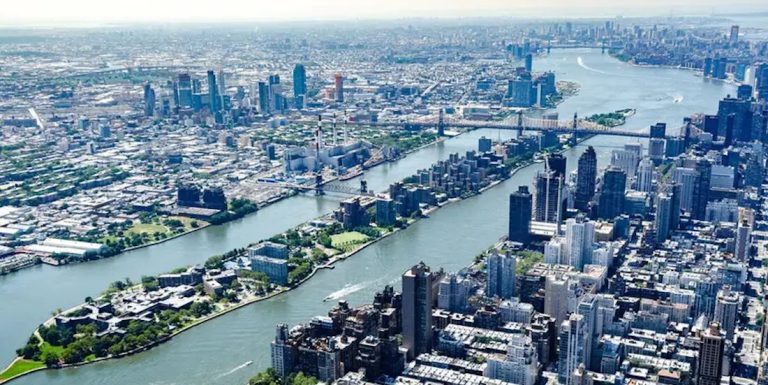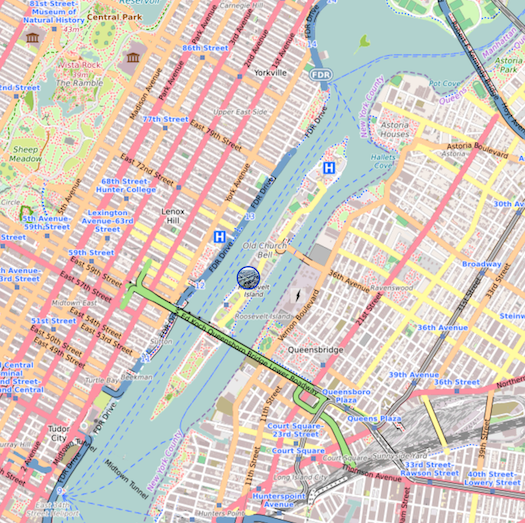
From “Welfare Island” to Vibrant Community Hub in Six Decades
New York, N.Y. — On July 24, 1959, a narrow strip of land in the East River between Manhattan and Queens officially became “Roosevelt Island,” marking the start of a remarkable transformation.

Once known as Welfare Island, this two-mile-long enclave has evolved from a place of asylums and hospitals into a vibrant, planned community that blends history, innovation, and urban serenity.
As the island celebrates its 66th anniversary as Roosevelt Island, its unique story reflects broader themes of urban renewal, community resilience, and forward-thinking urban planning in New York City.
A Storied Past: From Blackwell’s to Welfare Island
The island’s history predates its 1959 renaming. Originally called Blackwell’s Island, after the family that owned it in the 17th century, it served as a site for institutions like hospitals, asylums, and prisons.
In the 19th century, the island housed the New York City Lunatic Asylum, a smallpox hospital, and a penitentiary where notable figures like Emma Goldman and Mae West were once detained.
By the early 20th century, it was renamed Welfare Island, reflecting its role as a hub for medical and charitable facilities.
This period was marked by neglect and decay. The island’s aging infrastructure and isolated location made it a forgotten corner of the city. However, the mid-20th century brought a turning point.
In 1959, the island was officially designated Roosevelt Island in honor of President Franklin D. Roosevelt, signaling a new vision for its future. The renaming coincided with broader shifts in the U.S., as Hawaii and Alaska became states and the nation grappled with post-war growth and urban challenges.
A Bold Experiment in Urban Planning

In the 1960s, New York City officials saw an opportunity to reimagine Roosevelt Island as a model for urban development.
The Urban Development Corporation (U.D.C.), a state agency, acquired the island in 1969 and partnered with architects like Philip Johnson and John Burgee to design a master-planned community.
Their vision was ambitious: create a car-free, mixed-income neighborhood that prioritized affordability, green spaces, and accessibility.
The result was a residential community unlike any other in New York City. The island’s first modern residential buildings, completed in the 1970s, included Eastwood and Westview, designed to house a diverse population.
The Roosevelt Island Tramway, opened in 1976, became an iconic feature, offering residents a scenic commute to Manhattan while symbolizing the island’s innovative spirit.
The tramway, suspended over the East River, remains a beloved attraction, drawing tourists and locals alike.
The island’s layout emphasized pedestrian-friendly spaces, with wide pathways, riverfront promenades, and parks like Southpoint Park and Four Freedoms Park, the latter a memorial to Franklin D. Roosevelt opened in 2012.
These spaces reflect the island’s commitment to balancing urban density with natural beauty, creating a serene escape within the bustling city.
A Hub of Innovation: Cornell Tech and Beyond
In recent decades, Roosevelt Island has solidified its reputation as a hub for innovation. The establishment of the Cornell Tech campus in 2017 marked a significant milestone.

This graduate school, a partnership between Cornell University and Technion-Israel Institute of Technology, focuses on technology and entrepreneurship, attracting students, researchers, and startups to the island.
The campus’s modern architecture, including sustainable buildings like The House and Bloomberg Center, showcases cutting-edge design and environmental consciousness.
Some have expressed concern that research conducted here is being used for military applications including the Israeli invasion of Gaza and that nation’s “Iron Dome” defense system.
Cornell Tech has also spurred economic growth, creating jobs and fostering a tech ecosystem that complements the island’s residential character.
Many non-profits on the island, however, feel misled by Cornell’s original promises of accessibility that actually come with large “security fees.”
The campus’s presence has drawn global attention, positioning Roosevelt Island as a forward-thinking community within New York City’s tech landscape.
Yet, residents remain proud of the island’s small-town feel, with local events like the Roosevelt Island Day festival fostering a tight-knit community spirit.
Challenges and Resilience
Despite its successes, Roosevelt Island faces challenges. Its isolation, while a draw for some, can feel limiting. The tramway and the F train provide access to Manhattan and Queens, but transportation disruptions can leave residents stranded.
Rising costs in New York City have also strained the island’s affordability, with some longtime residents worrying about gentrification as new developments attract wealthier newcomers.
The island’s governance, managed by the Roosevelt Island Operating Corporation (RIOC), has sparked debates over transparency and community input. Residents have advocated for greater say in decisions, from park maintenance to development projects.
Yet, the community’s resilience shines through. Grassroots organizations such as the Roosevelt Island Visual Arts Association (RIVAA) and local leaders work tirelessly to preserve the island’s unique character while embracing growth.

Looking Ahead: A Model for Urban Living
As Roosevelt Island marks its 66th year, it stands as a testament to the power of visionary urban planning. Its blend of history, innovation, and community offers lessons for cities worldwide.
The island’s car-free ethos, green spaces, and mixed-income housing model remain relevant as urban areas grapple with sustainability and inclusivity.
Future plans include expanding recreational facilities and enhancing accessibility, with potential upgrades to the tramway and public transit.
The island’s commitment to sustainability aligns with New York City’s broader goals, such as reducing carbon emissions and promoting equitable development.
As Cornell Tech continues to grow, the island is poised to remain a leader in tech-driven urban innovation.
Roosevelt Island Turns 66: A Unique New York City Gem (July 11, 2025)
Summary
Roosevelt Island, born on July 24, 1959, transformed from Welfare Island into a thriving New York City community. This 66-year-old enclave in the East River blends history, modern urban planning, and unique charm. From asylums to family-friendly neighborhoods, it now boasts parks, the Cornell Tech campus, and the iconic tramway, offering a serene escape within the bustling city.